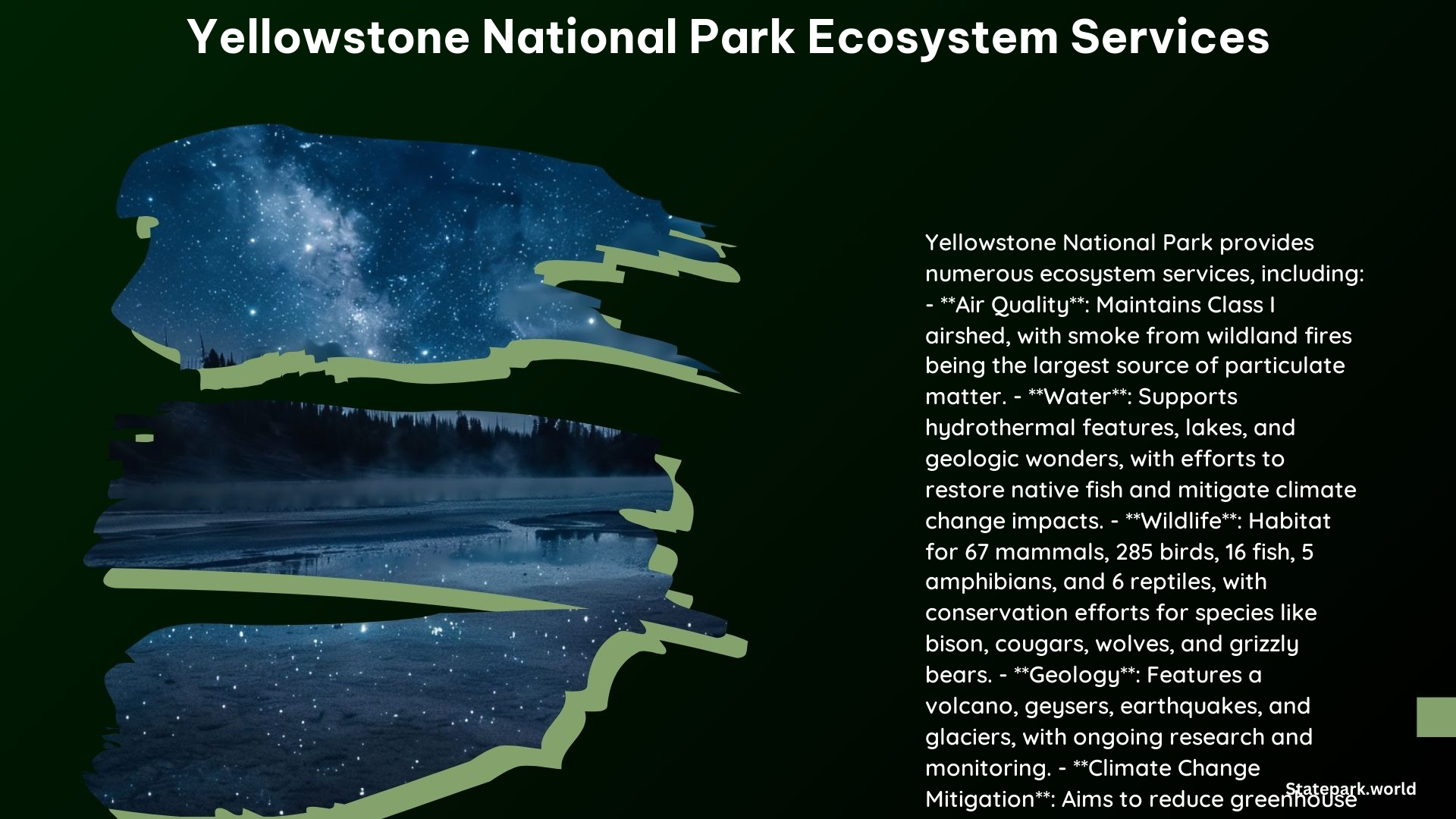Yellowstone National Park is a natural wonder that provides a wide range of ecosystem services crucial for both human well-being and the conservation of wildlife in the region. From maintaining air and water quality to supporting wildlife and regulating the climate, Yellowstone’s diverse ecosystems play a vital role in sustaining the delicate balance of the Greater Yellowstone Ecosystem.
Air Quality: Preserving the Pristine Airshed
Yellowstone National Park is designated as a Class I airshed, which means it has minimal air pollution and is considered a pristine area. The park’s natural systems, such as its forests and vegetation, help maintain clean air, which is essential for human health and the well-being of wildlife.
Water Quality: Safeguarding the Park’s Aquatic Treasures

The park’s natural processes, including its hydrothermal features and geologic wonders, contribute to the maintenance of clean water sources. This is critical for both human consumption and the support of aquatic life, ensuring the health and vitality of the park’s diverse water bodies.
Wildlife Conservation: Protecting Yellowstone’s Diverse Inhabitants
Yellowstone National Park is home to an incredible array of wildlife, including 67 mammals, 285 birds, 16 fish, 5 amphibians, and 6 reptiles. The park’s ecosystem supports the conservation of these species by providing essential habitat, food, and other resources necessary for their survival and thriving.
Carbon Sequestration: Mitigating Climate Change
The park’s forests and other vegetation play a crucial role in absorbing carbon dioxide from the atmosphere, contributing to the mitigation of climate change. This ecosystem service helps to offset greenhouse gas emissions and supports the long-term sustainability of the Greater Yellowstone Ecosystem.
Soil Formation and Nutrient Cycling: Sustaining the Park’s Productivity
Yellowstone’s geologic processes, such as volcanic activity and forest fires, contribute to soil formation and nutrient cycling. This supports the growth of vegetation and maintains the overall health and productivity of the park’s ecosystems.
Climate Regulation: Moderating the Region’s Weather Patterns
Yellowstone’s natural systems help regulate the climate by storing carbon, moderating temperatures, and influencing local weather patterns. This ecosystem service is crucial for maintaining the delicate balance of the Greater Yellowstone Ecosystem and supporting the diverse range of species that call the park home.
Recreation and Tourism: Connecting People with Nature
Yellowstone National Park provides abundant opportunities for recreation, tourism, and education, which support local economies and promote the appreciation and conservation of the park’s natural resources. Visitors can explore the park’s iconic landscapes, witness the awe-inspiring geothermal features, and immerse themselves in the rich cultural and historical heritage of the region.
Scientific Research: Informing Conservation Efforts
Yellowstone serves as a natural laboratory for scientists to study and monitor ecosystem changes, providing valuable insights that inform conservation efforts and policy decisions. The park’s diverse ecosystems and natural processes offer a wealth of research opportunities, contributing to our understanding of the complex dynamics of the Greater Yellowstone Ecosystem.
Cultural and Historical Significance: Preserving the Past
Yellowstone National Park preserves cultural and historical resources, including archaeological sites and Native American artifacts, which are essential for understanding human history and cultural diversity. These resources not only hold intrinsic value but also contribute to the park’s educational and interpretive programs, fostering a deeper appreciation for the region’s heritage.
Ecosystem Resilience: Adapting to Change
Yellowstone’s ecosystem is highly resilient due to its natural processes and minimal human alteration. This resilience helps the ecosystem adapt to changes such as climate change and supports the long-term conservation of wildlife, ensuring the continued preservation of the park’s natural wonders for generations to come.
Yellowstone National Park’s diverse ecosystem services are the foundation for the conservation and protection of the Greater Yellowstone Ecosystem. By understanding and appreciating these essential services, we can work to ensure the long-term sustainability of this natural treasure and the wildlife that call it home.
References:
– National Park Service. (2017). Air Quality and Ecosystem Services. Retrieved from https://www.nps.gov/articles/air-quality-and-ecosystem-services.htm
– National Park Service. (2023). Nature – Yellowstone National Park. Retrieved from https://www.nps.gov/yell/learn/nature/index.htm
– National Park Service. (2023). Greater Yellowstone Ecosystem. Retrieved from https://www.nps.gov/yell/learn/upload/3_RI_2023_GYE_508web.pdf
– National Park Service. (2023). Strengthening the Yellowstone Ecosystem & Heritage Resources. Retrieved from https://www.nps.gov/yell/learn/management/strengthening-the-yellowstone-ecosystem-heritage-resources.htm
– National Park Service. (2020). Greater Yellowstone Ecosystem. Retrieved from https://www.nps.gov/yell/learn/nature/greater-yellowstone-ecosystem.htm
